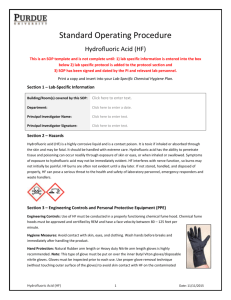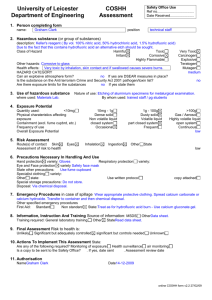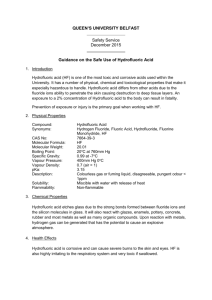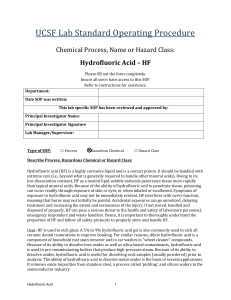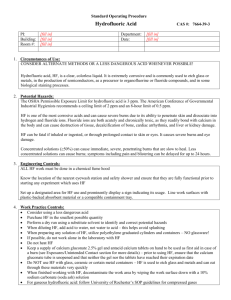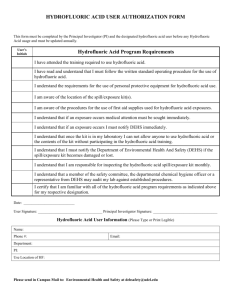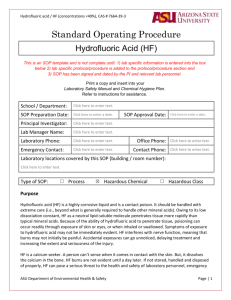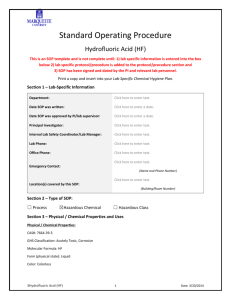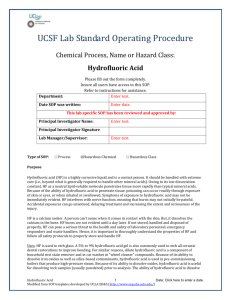Hydrofluoric Acid - UCLA David Geffen School of Medicine
advertisement
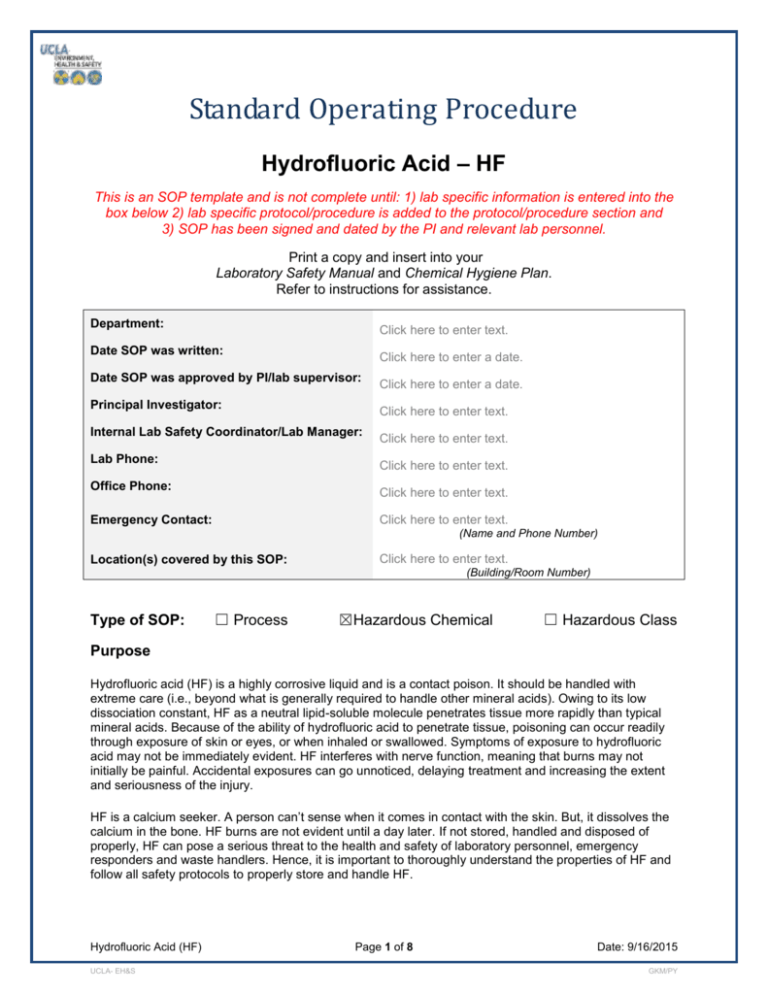
Standard Operating Procedure Hydrofluoric Acid – HF This is an SOP template and is not complete until: 1) lab specific information is entered into the box below 2) lab specific protocol/procedure is added to the protocol/procedure section and 3) SOP has been signed and dated by the PI and relevant lab personnel. Print a copy and insert into your Laboratory Safety Manual and Chemical Hygiene Plan. Refer to instructions for assistance. Department: Click here to enter text. Date SOP was written: Click here to enter a date. Date SOP was approved by PI/lab supervisor: Principal Investigator: Click here to enter text. Internal Lab Safety Coordinator/Lab Manager: Lab Phone: Click here to enter a date. Click here to enter text. Click here to enter text. Office Phone: Click here to enter text. Emergency Contact: Click here to enter text. (Name and Phone Number) Location(s) covered by this SOP: Click here to enter text. (Building/Room Number) Type of SOP: ☐ Process ☒Hazardous Chemical ☐ Hazardous Class Purpose Hydrofluoric acid (HF) is a highly corrosive liquid and is a contact poison. It should be handled with extreme care (i.e., beyond what is generally required to handle other mineral acids). Owing to its low dissociation constant, HF as a neutral lipid-soluble molecule penetrates tissue more rapidly than typical mineral acids. Because of the ability of hydrofluoric acid to penetrate tissue, poisoning can occur readily through exposure of skin or eyes, or when inhaled or swallowed. Symptoms of exposure to hydrofluoric acid may not be immediately evident. HF interferes with nerve function, meaning that burns may not initially be painful. Accidental exposures can go unnoticed, delaying treatment and increasing the extent and seriousness of the injury. HF is a calcium seeker. A person can’t sense when it comes in contact with the skin. But, it dissolves the calcium in the bone. HF burns are not evident until a day later. If not stored, handled and disposed of properly, HF can pose a serious threat to the health and safety of laboratory personnel, emergency responders and waste handlers. Hence, it is important to thoroughly understand the properties of HF and follow all safety protocols to properly store and handle HF. Hydrofluoric Acid (HF) UCLA- EH&S Page 1 of 8 Date: 9/16/2015 GKM/PY Uses: HF is used to etch glass. A 5% to 9% hydrofluoric acid gel is also commonly used to etch all ceramic dental restorations to improve bonding. For similar reasons, dilute hydrofluoric acid is a component of household rust stain remover and in car washes in "wheel cleaner" compounds. Because of its ability to dissolve iron oxides as well as silica-based contaminants, hydrofluoric acid is used in precommissioning boilers that produce high-pressure steam. Because of its ability to dissolve oxides, hydrofluoric acid is useful for dissolving rock samples (usually powdered) prior to analysis. The ability of hydrofluoric acid to dissolve metal oxides is the basis of several applications. It removes oxide impurities from stainless steel, a process called ‘pickling’, and silicon wafers in the semiconductor industry. Physical & Chemical Properties/Definition of Chemical Group CAS#: 7664-39-3 Class: Very toxic & Corrosive Molecular Formula: HF Form (physical state): Liquid Color: Colorless Boiling point: Not applicable Potential Hazards/Toxicity HF removes calcium from body in the affected area (Targets the bone). Target Organs - Liver, Kidney Potential Health Effects Inhalation Toxic if inhaled. Material is extremely destructive to the tissue of the mucous membranes and upper respiratory tract. Skin May be fatal if absorbed through skin. Causes skin burns. Eyes Causes eye burns. Causes severe eye burns. Ingestion May be fatal if swallowed. Personal Protective Equipment (PPE) Respiratory Protection Respirators should be used only under any of the following circumstances: As a last line of defense (i.e., after engineering and administrative controls have been exhausted). When Permissible Exposure Limit (PEL) has exceeded or when there is a possibility that PEL will be exceeded. Regulations require the use of a respirator. An employer requires the use of a respirator. Hydrofluoric Acid (HF) UCLA- EH&S Page 2 of 8 Date: 9/16/2015 GKM/PY There is potential for harmful exposure due to an atmospheric contaminant (in the absence of PEL) As PPE in the event of a chemical spill clean-up process Lab personnel intending to use/wear a respirator mask must be trained and fit-tested by EH&S. This is a regulatory requirement. (https://www.ehs.ucla.edu/ep/ih/resp) Hand Protection Natural Rubber arm length or Heavy duty Nitrile arm length gloves is highly recommended. Note: This type of gloves must be put on over the inner Butyl Viton gloves/disposable nitrile gloves. Gloves must be inspected prior to each use. Use proper glove removal technique (without touching outer surface of the gloves) to avoid skin contact with HF on the contaminated gloves. Dispose of inner nitrile gloves after use as hazardous waste. *Inner Butyl Viton gloves can be reused carefully (i.e., without touching the outer surface of the gloves). Wash hands thoroughly with warm water and soap. NOTE: Consult with your preferred glove manufacturer to ensure that the gloves you plan on using are compatible with Hydrofluoric acid.. Refer to glove selection chart from the links below: http://www.ansellpro.com/download/Ansell_8thEditionChemicalResistanceGuide.pdf OR http://www.allsafetyproducts.com/glove-selection-chart-chemical-breakthrough-ratings.html OR http://www.showabestglove.com/site/default.aspx OR http://www.mapaglove.com/ Eye Protection Tightly fitting safety goggles & face shield (ANSI approved). Skin and Body Protection Lab coat & natural rubber apron Full-length pants Closed-toe rubber or leather shoes NOTE: If HF is used in a cleanroom, the cleanroom gown will substitute for lab coat and full length pants. In addition, all the other PPE listed in this section is applicable. Hygiene Measures Avoid contact with skin, eyes and clothing. Wash hands before breaks and immediately after handling the product. Engineering Controls To be used on a chemical wet bench or annually certified chemical fume hood. First Aid Procedures If inhaled Move to fresh air. If the person is not breathing, give artificial respiration. Avoid mouth to mouth contact. Call 911 from a campus phone or 310-825-1491 from a cell phone. Call EH&S at 310-825-9797. In case of skin contact Immediately (within seconds) flush affected area for at least 15 minutes. Remove all contaminated clothing. Call 911 from a campus phone or 310-825-1491 from a cell phone. Call EH&S at 310-825-9797. Wearing compatible gloves, massage calcium gluconate gel into the affected area. Re-apply every 15 minutes until medical help arrives. Note: Hydrofluoric acid exposure is often treated with calcium Hydrofluoric Acid (HF) UCLA- EH&S Page 3 of 8 Date: 9/16/2015 GKM/PY gluconate, a source of Ca2+ that sequesters the fluoride ions. HF chemical burns can be treated with a water wash and 2.5% calcium gluconate gel, or special rinsing solutions. However, because it is absorbed, medical treatment is necessary; rinsing off is not enough. Intra-arterial infusions of calcium chloride have also shown great effectiveness in treating burns. In some cases, amputation may be required. In case of eye contact Use Calgonate Emergency Eyewash immediately. Call 911 from a campus phone or 310-825-1491 from a cell phone. Call EH&S at 310-825-9797. NOTE: Do not open the Calgonate Emergency Eyewash Solution container seal, unless needs to be used. Use the entire 120 ml content during an emergency (eye exposure). Calgonate Emergency Eyewash Solution is for single use only. If swallowed DO NOT INDUCE VOMITING. Give large quantities of milk (preferable) or water. Never give anything by mouth to an unconscious person. Call 911 from a campus phone or 310-825-1491 from a cell phone. Call EH&S at 310-825-9797. Special Storage & Handling Requirements Ensure that you have all the PPE required for handling HF. HF must always be stored in plastic (nalgene / polypropylene) containers. DO NOT store HF in glass bottles/containers. Store in corrosive/acid storage cabinet within a secondary containment (nalgene/ polypropylene tray or tub). Do not store in the top most shelf of the storage cabinet. Note: In general, do not store chemicals at or above eye level. Ensure the container is tightly closed at all times. Do not store with oxides, organic chemicals, bases or metals. Carefully carry the stock bottle in a rubber maid bottle carrier/nalgene secondary container to the wet bench/chemical fume hood and pour out desired amount into a smaller container. Place stock bottle back in corrosive chemical storage cabinet with cap tightly closed. Lab buddy system is highly recommended when handling HF. Lab emergency contact information must be readily available. The lab personnel must have easy access to a telephone (landline or cell phone). Spill and Accident Procedure General Guidelines: Personal precautions Wear respiratory protection. Avoid breathing vapors, mist or gas. Ensure adequate ventilation. Evacuate personnel to safe areas. Environmental precautions Prevent further leakage or spillage if safe to do so. Do not let product enter drains. Methods and materials for containment and cleaning up Soak up with inert absorbent material and dispose of as hazardous waste. Keep in suitable, closed containers for disposal. Hydrofluoric Acid (HF) UCLA- EH&S Page 4 of 8 Date: 9/16/2015 GKM/PY Personal Protective equipment must be worn – natural rubber gloves (arm length), goggles, face shield, natural rubber apron/suit, long pants, closed-toe rubber/leather shoes, respirator approved for HF handling. Immediately assess amount spilled. Contact Environment Health & Safety (EH&S) at x59797 and dial 911 from a campus phone (310-825-1491 from a cell phone). Use neutralizing agent (sodium carbonate) and liquid binding material (vermiculite, sand, kitty litter). Pick up contaminated material with a disposable scoop and place in a double transparent plastic bag. Label and tag as hazardous waste and bring to hazardous waste pick up. Chemical Spill: Call 911 from a campus phone or 310-825-1491 from a cell phone. Call EH&S at 310-825-9797. Medical Emergency Dial 911 or x52111 Life Threatening Emergency, After Hours, Weekends And Holidays – Dial 911 (or 310-825-1491 from cell phone) or contact the Ronald Reagan UCLA Medical Center (emergency room) directly at x52111 (located at 757 Westwood Plaza, enter from Gayley Avenue). Note: All serious injuries must be reported to EH&S at x59797 within 8 hours. Non-Life Threatening Emergency – Go to the Occupational Health Facility (OHF), x56771, CHS room 67-120 (This is on the 6th floor, 7th corridor, room 120. Enter through the School of Dentistry on Tiverton Drive and proceed to the “O” elevator to the 6th floor.)Hours: M - F, 7:30 a.m. to 4:30 p.m. At all other times report to Ronald Regan UCLA Medical Center (emergency room) at x52111. Note: All serious injuries must be reported to EH&S at x59797 within 8 hours. Needle stick/puncture exposure (as applicable to chemical handling procedure) – Wash the affected area with antiseptic soap and warm water for 15 minutes. For mucous membrane exposure, flush the affected area for 15 minutes using an eyewash station. Page the needle stick nurse by dialing 231 from a campus phone, enter 93333 when prompted and then enter your extension. Hours: M – F, 8:00 a.m. to 4:00 p.m. At all other times report to Ronald Regan UCLA Medical Center (emergency room) at x52111. Note: All needle stick/puncture exposures must be reported to EH&S at x59797 within 8 hours. Decontamination/Waste Disposal Procedure HF is listed as Extremely Hazardous (EH) Substance by the State. Even the containers (irrespective of the size) which once held HF must be disposed of as hazardous waste with an on-line hazardous waste tag affixed on the container. (http://map.ais.ucla.edu/go/1002774) Even the safety gloves that come in contact with HF (i.e., HF contaminated gloves) must be disposed of as dry hazardous waste. All dry hazardous waste must be double bagged (use only transparent bags) and affixed with an on-line waste tag. General hazardous waste disposal guidelines: Label Waste Affix an on-line hazardous waste tag on all waste containers using the WASTe Online Tag Program https://ehs.ucop.edu/waste as soon as the first drop of waste is added to the container Store Waste Store hazardous waste in closed containers, in secondary containment and in a designated location Double-bag dry waste using transparent bags https://www.ehs.ucla.edu/hazwaste/management/containers Hydrofluoric Acid (HF) UCLA- EH&S Page 5 of 8 Date: 9/16/2015 GKM/PY Waste must be under the control of the person generating & disposing of it Dispose of Waste Dispose of regularly generated chemical waste within 90 days Call EH&S at x61887 for questions Empty Containers o Dispose as hazardous waste if it once held extremely hazardous waste (irrespective of the container size) https://www.ehs.ucla.edu/hazwaste/types/extremely-hazardous o Consult waste pick-up schedule o https://www.ehs.ucla.edu/hazwaste/management/pick-ups Prepare for transport to pick-up location Check on-line waste tag Write date of pick-up on the waste tag Use secondary containment Safety Data Sheet (SDS) Location Online SDS can be accessed at http://msds.ehs.ucla.edu. Protocol/Procedure Quantities covered by this SOP: 0 - 20ml from a 500 g reagent bottle Conditions covered by this SOP 0℃ - 37℃ 1. Never use Hydrofluoric Acid when working alone after hours. Hydrofluoric Acid may be used when working alone during normal working hours provided knowledgeable laboratory personnel have been alerted and at least one is in the general vicinity to provide assistance if necessary. The LS/PI must be notified prior to any unaccompanied use of HF. 2. All lab personnel, not just those who will be using Hydrofluoric Acid, must be informed of the dangers of this chemical and the emergency procedures necessary in case of an accident. A sign should be posted to alert people that work with Hydrofluoric Acid is in progress. 3. All persons who use Hydrofluoric Acid must be made aware of its properties and trained in proper procedures for use and disposal. The LS/PI is responsible for providing this training. 4. Laboratories which keep or use Hydrofluoric Acid gas or concentrated solutions (>1% Hydro fluoric Acid) must have these emergency procedures on hand as well as the appropriate SDS. 5. Laboratories which keep or use Hydrofluoric Acid gas or concentrated solutions (>1% Hydro fluoric Acid) must have an operational safety shower and eye wash in their laboratory. Before beginning any procedure involving Hydrofluoric Acid, make sure the access to the emergency shower and eyewash is unobstructed. 6. Undergraduate students should never be given the task of mixing Hydrofluoric Acid solutions. Only experienced persons familiar with its properties should handle the concentrated acid. The LS/PI is responsible for ensuring appropriately trained individuals mix hydrofluoric acid solutions. 7. A small supply of appropriate neutralizer for spills should be kept near the fume hood where the work will be conducted. If a small quantity (100 ml or less) of dilute Hydrofluoric Acid solution is spilled, clean it up by absorbing spilled material with the supplies in the Chemical Response Kit, and apply neutralizer to decontaminate surfaces. In some instances, powdered calcium carbonate or calcium hydroxide may be used to neutralize spilled material. If a larger amount is spilled, or if the acid is concentrated, contain the spill as best as you can use supplies in the Chemical Response Kit, evacuate the area, and call 911. Avoid exposure to the vapors. 8. Dispose of unwanted hydrofluoric acid or spill cleanup materials by submitting online waste pickup requests to: http://otp.ucop.edu 9. When working with Hydrofluoric Acid or concentrated HF solutions (> 1%): Hydrofluoric Acid (HF) UCLA- EH&S Page 6 of 8 Date: 9/16/2015 GKM/PY a. b. c. d. e. f. Work in a fume hood with the sash as low as possible. Wear PPE as defined above. Wear a long-sleeved, buttoned lab coat, pants or long skirt, and closed-toe shoes. Wear thick Neoprene or Nitrile gloves or HF-resistant gloves. The LS/PI must be notified before any work with hydrofluoric acid occurs outside the chemical fume hood. Any exposure to Hydrofluoric Acid must be medically evaluated. HF is used to etch glass. A 5% to 9% hydrofluoric acid gel is also commonly used to etch all ceramic dental restorations to improve bonding. NOTE Any deviation from this SOP requires approval from PI. Documentation of Training (signature of all users is required) Prior to conducting any work with Hydrofluoric Acid (HF)., designated personnel must provide training to his/her laboratory personnel specific to the hazards involved in working with this substance, work area decontamination, and emergency procedures. The Principal Investigator must provide his/her laboratory personnel with a copy of this SOP and a copy of the SDS provided by the manufacturer. The Principal Investigator must ensure that his/her laboratory personnel have attended appropriate laboratory safety training or refresher training within the last one year. Principal Investigator SOP Approval Print name __________________________Signature___________________________ Approval Date: I have read and understand the content of this SOP: Name Signature Click here to enter text. Date Click here to enter a date. Click here to enter a date. Click here to enter text. Click here to enter text. Click here to enter a date. Click here to enter text. Click here to enter a date. Click here to enter text. Click here to enter a date. Click here to enter text. Click here to enter a date. Hydrofluoric Acid (HF) UCLA- EH&S Page 7 of 8 Date: 9/16/2015 GKM/PY Click here to enter text. Click here to enter a date. Click here to enter text. Click here to enter a date. Click here to enter text. Click here to enter a date. Click here to enter text. Click here to enter a date. Click here to enter text. Click here to enter a date. Click here to enter text. Click here to enter a date. Click here to enter text. Click here to enter a date. Click here to enter a date. Click here to enter text. Click here to enter text. Hydrofluoric Acid (HF) UCLA- EH&S Click here to enter a date. Page 8 of 8 Date: 9/16/2015 GKM/PY
